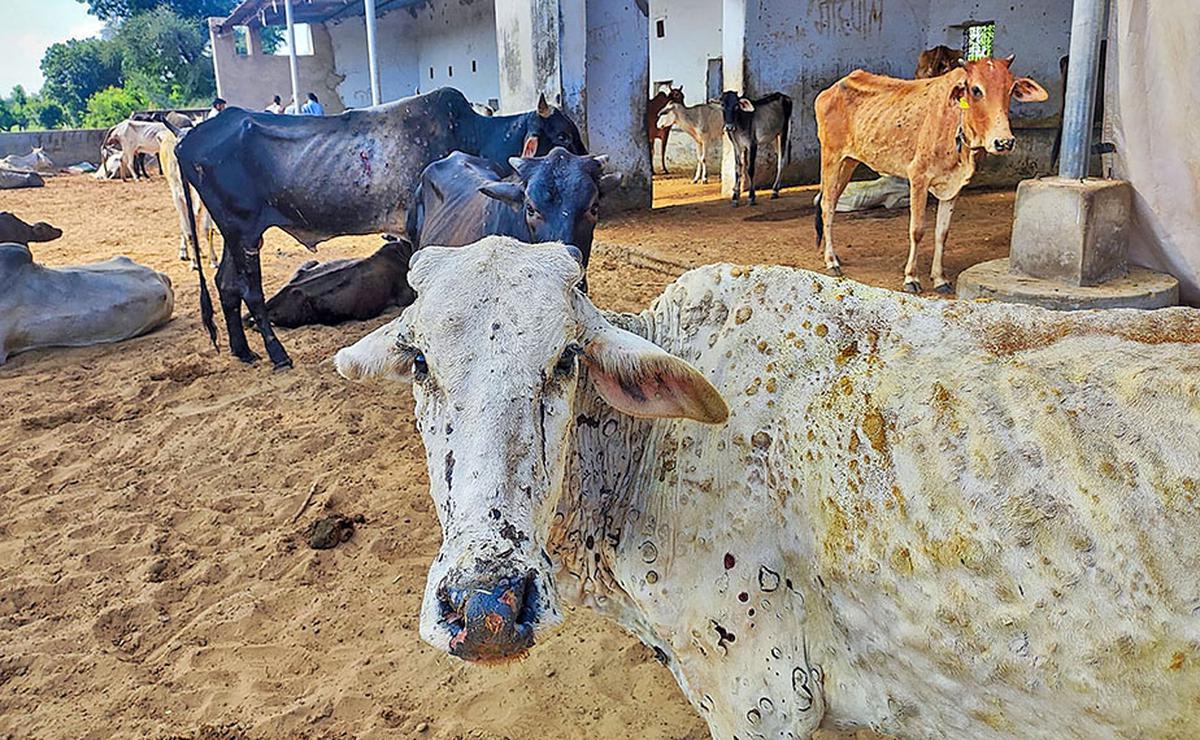Lumpy skin disease (LSD) is a viral infection that primarily affects cattle. In Uttarakhand, over 4000 cases of LSD have been recorded in June alone. On 11th June,10 cattle died of the disease, taking the total number of deaths to 303.
The hill districts of Pithoragarh and Bageshwar have been the worst affected.
According to the TOI article, Uttarakhand has 2076 active cases with a 1.86% fatality rate,13856 livestock have recovered and the recovery percentage is 85.34%.
Understanding Lumpy Skin Disease
Lumpy skin disease is predominantly found in cattle, affecting both dairy and beef breeds. The disease is characterized by the formation of firm, nodular skin lesions, which give it its name. These nodules can appear on various parts of the body, including the skin, mucous membranes, and internal organs. LSDV is highly contagious and can spread rapidly within cattle herds and between different farms or regions. The disease is primarily transmitted through direct contact with infected animals, but it can also be transmitted by biting insects, such as mosquitoes and ticks.
Impact on Humans
While lumpy skin disease primarily affects cattle, there have been rare cases of human infections reported. Human infections with LSDV are believed to occur through direct contact with infected animals or their tissues, such as through cuts in the skin. The virus can cause a range of symptoms in humans, including:
1. Localized Lesions: In humans, LSDV can cause skin lesions similar to those seen in infected cattle.
2. Flu-like Symptoms: Some individuals may experience mild flu-like symptoms, including fever, headache, and body aches.
It's important to note that human infections with LSDV are rare, and the disease is not considered a significant public health threat. However, individuals working closely with infected animals, such as farmers, and veterinary professionals, should take appropriate precautions to minimize the risk of transmission.
Prevention and Control Measures
Preventing the spread of lumpy skin disease in both cattle and humans involves implementing effective control measures. Some key strategies include:
1. Vaccination: Vaccination is a crucial tool in preventing and controlling LSD in cattle. Several vaccines have been developed and are available in regions where the disease is endemic or has emerged.
2. Quarantine and Movement Restrictions: Infected animals should be identified, isolated, and quarantined to prevent the spread of the disease.
3. Vector Control: Implementing measures to control biting insects, such as mosquitoes and ticks, can help reduce the transmission of LSDV between cattle herds.
4. Hygiene Practices: Practicing good hygiene, including regular handwashing and the use of appropriate personal protective equipment when handling infected animals or their tissues, is essential to minimize the risk of human infections.
Ongoing Research
As lumpy skin disease continues to pose challenges to the livestock industry and has the potential for human infections, ongoing research efforts are focused on better understanding the virus, developing more effective vaccines, and improving control strategies.
In conclusion, lumpy skin disease is a viral infection that primarily affects cattle but can have implications for human health. While human infections are rare and generally mild, preventive measures, such as vaccination, quarantine can reduce the possibility of infection
http://www.21stcenturyhospitalgownplus.com/
http://www.elite-factory-15.fr/
http://www.gba-amateurboxen.de/
http://www.kita-strausberg.de/
http://sonispicehelensburgh.co.uk/
http://curryzonecardonald.co.uk/
http://cinnamon-edinburgh.co.uk/
http://www.bombaydelipaisley.com/
http://pizzanightclydebank.co.uk/
http://www.pizzanightclydebank.com/
http://gyros2goclydebank.co.uk/
http://grillicious-glasgow.co.uk/
http://www.abdulstakeaway.com/
http://www.freddiesfoodclub.com/
http://cinnamonportobello.co.uk/
http://www.romafishnchips.com/
http://bombaydelipaisley.co.uk/
http://yaraloungerestaurant.co.uk/
http://tasteofchinacoatbridge.co.uk/
http://www.memoriesofindiagorebridge.com/
http://memoriesofindiaeh23.co.uk/
http://freddiesknightswood.co.uk/
http://gyros2gohardgate.co.uk/
http://www.strausseeschwimmen.de/
http://www.janstanislawwojciechowski.pl/
http://london-takeaways.co.uk/
http://shahimanziledinburgh.co.uk/
http://freddiesfoodclub.co.uk/
http://www.spicestakeaway.com/
http://www.mexita-paisley.com/
http://pandahouseglasgow.co.uk/
http://www.zum-alten-steuerhaus.de/
http://www.oberstufenzentrum-mol.org/
http://www.morsteins-neuenhagen.de/
http://www.maerkische-jugendweihe.de/
http://www.planungsbuero-henschel.de/
http://www.hertzelektronik.de/
http://www.militaergefaengnisschwedt.de/
http://www.fahrrad-naumann.de/
http://www.hondamoto-villemomble.com/
http://www.hondamoto-royan.com/
http://www.hondamoto-ajaccio.com/
http://www.download-skycs.com/
http://www.sisakoskameleon.hu/
http://www.hondamoto-montauban.com/
http://www.hondamoto-chalonsursaone.com/
http://www.hondamoto-champignysurmarne.com/
http://www.hondamoto-asnieres.com/
http://www.pasquier-motos.com/
http://www.evacollegeofayurved.com/
http://www.compro-oro-italia.it/
http://www.hondamoto-saintmaximin.com/
http://www.hoangminhceramics.com/
http://www.pasiekaambrozja.pl/
http://www.xn--b1alildct.xn--p1ai/
http://www.ferreteriaflorencia.com/
http://www.thevichotelkisumu.com/
http://www.nexuscollection.com/
http://www.moitruongminhhuy.com/
http://www.ozkayalarpaslanmaz.com/
http://www.munkagepmonitor.hu/
http://www.my247webhosting.com/
http://www.thesmokingribs.com/
http://www.healthlabgrosseto.it/
http://www.ochranakaroserie.cz/
http://www.phukiendonginox.com/
http://www.meijersautomotive.nl/
http://www.kartaestudentit.al/
http://www.podlahyjihlavsko.cz/
http://www.hillhouseequestrian.com/
http://www.gradskapivnicacitadela.com/
http://www.capella-amadeus.de/
http://www.landfleischerei-auris.de/
http://www.faistesvacances.be/
http://www.autoservice-doernbrack.de/
http://www.tabakhaus-durek.de/
http://www.oldtimer-strausberg.de/
http://www.imexsocarauctions.com/
http://www.kaslikworkshop.com/
http://www.firefightercpr.com/
http://www.visuallearningsys.com/
http://www.hanksautowreckers.com/
http://www.impresospichardo.com/
http://www.philiphydraulics.net/
http://www.internationaldentalimplantassociation.com/
http://www.indywoodtalenthunt.com/
http://www.badicecreamgame.com/
http://www.riad-amarrakech.com/
http://www.centrodeformacioncanario.com/
http://www.socialdefender.com/
http://www.pepiniere-paravegetal.com/
http://www.reparertelephonearles.fr/
http://www.namsontrongdoi.com/
http://www.devipujakjivansathiseva.in/
http://www.laymissionhelpers.org/
http://www.vangiaphatdeco.com/
http://www.isscoachinglucknow.in/
http://www.hieuchuandoluong.com/
http://www.aurorabienesraices.com/
http://www.indianmoversassociation.com/
http://www.oztopraklarotomotiv.com/
http://moitruongnamnhat.com.vn/
http://www.dienmayvinhthuan.vn/
http://www.divadelkoproskoly.cz/
http://www.xn--12cfje1df4hdl7f1bf2evg9e.com/
http://www.westernirontrailers.com/
http://www.jazzaufildeloise.fr/
http://www.signcraft-drone.com/
http://www.realtyhighvision.com/
http://www.thermexscandinavia.nl/
http://imobiliariafelipe.com.br/
http://www.salon-lindenoase.de/
http://www.jezirka-zahrada.cz/
http://www.singhanialogistics.in/
http://www.der-pixelmischer.de/
http://www.hegermuehlen-grundschule.de/
http://www.radiologie-strausberg.de/
http://www.foto-studio-matte.de/
http://www.tables-multiplication.com/
http://www.rusztowania-belchatow.pl/
http://www.fishingandhuntingheaven.com/
http://www.orologiegioiellilameridiana.it/
http://www.rotarybresciaest.org/
http://www.jacarandaspain.com/
http://www.javieririberri.com/
http://www.huebelschraenzer.ch/
http://www.illinoiscreditunionjobs.com/
http://www.iznikdenizorganizasyon.com/
http://www.leasebackconcierge.com/
http://www.eoisantacoloma.org/
http://skullbasesurgery.co.uk/
http://www.immobilienplattensee.com/
http://www.germandailynews.com/
http://www.gptdcinternational.com/
http://www.forklifttrainingedmonton.com/
http://www.kashiwanakayama-cl.com/
http://www.thehousemediagroup.com/
http://www.pensiimaramures.ro/
http://www.michaelakokesova.cz/
http://www.viswabrahmanaeducationaltrust.com/
http://krone-aluminium.com.pl/
http://www.broadwaylumber.com/
http://www.ambulancesoccasions.com/
http://www.continuumintegrated.com/
http://www.joilifemarketing.com/
http://www.rotaseydisehir.com/

 Lumpy skin disease is predominantly found in cattle, affecting both dairy and beef breeds. The disease is characterized by the formation of firm, nodular skin lesions, which give it its name.
Lumpy skin disease is predominantly found in cattle, affecting both dairy and beef breeds. The disease is characterized by the formation of firm, nodular skin lesions, which give it its name.










.jpeg)


.jpeg)
.jpeg)
.jpeg)
_(1).jpeg)

_(1)_(1)_(1).jpeg)
.jpeg)
.jpeg)
.jpeg)








.jpeg)
.jpeg)